Elephant Pass: From battlefield to salt capital
[TamilNet, Friday, 05 September 2003, 01:19 GMT]
Before 1990, Elephant Pass and Kurunchativu located 10km
apart had the largest salterns in the northeast with a combined area of 100 acres, and produced more than 85,000 metric tons of salt a year. This output met all the salt needs of SriLanka and left enough surplus for export. These salterns, destroyed during the war, are being reconstructed and rehabilitated, and are currently producing close to 15% of the total capacity.
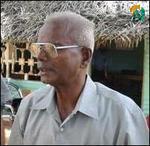 |
| S. Velauthapillai, former manager at Salt Corporation brought back to oversee the rebuilding of Elephant Pass salt production facility
|
The British monopolized all salt production in Sri Lanka under their control in 1938 with the establishment of the Salt Department in the wake of the ‘Salt Satyagraha’ by Mahatma Gandhi in India. The Salt Department was made the National Salt Corporation in 1966. All salterns in Sri Lanka were under the corporation before 1990.
From 1990 until the Sri Lanka Army's (SLA's) Elephant Pass garrison was captured by the Liberation Tigers (LTTE) in 2000 the salterns in Elephant Pass and Kurunchativu were unattended and the timber lining the edges of salt pans were removed by the SLA for military purposes. Salt production ground to a halt.
With the area coming under LTTE control, The Economic Consultancy House (TECH), an NGO operating in the Northeast, successfully wooed 35 year veteran of salt industry S. Velauthapillai to relocate to
Elephant Pass to rehabilitate the destroyed salt tank system and to oversee the building a new salt production facility.
 |
| Mahilan, salt manager at Elephant Pass
|
"We have been successful in getting 10 acres of salt pans back into production. With the Rs.4.8M assistance from UNICEF we have also constructed an iodization plant. Additionally a new facility is being constructed to store the stock piles of salt," said Mr. Velauthapillai.
"Salt water is left in large rectangular pans (tanks) exposed to sun light. Evaporation increases the salt concentration and salt crystals begin to form. After the salt crop reaches the appropriate thickness, the salt is harvested, washed, and placed on stockpile to drain. Clean brine, made by dissolving fine salt, is used to wash the salt to remove small amounts of impurities such as magnesium sulfate.
"Salt is then taken to our iodization and packing facility that we built with assistance from UNICEF. We have mainly women workers at this packing plant. These laborers stay in a hostel close to the plant during the week," said Mr. Velauthapillai.
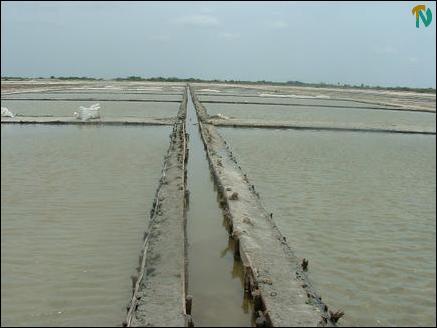 Feeder canals that carry salt water from lagoon to salt tanks.
Feeder canals that carry salt water from lagoon to salt tanks."A healthy individual consumes nearly 3 kgm of salt per year and needs 150 micrograms of iodine per day. Iodization of salt dates back to the research by David Marine (1880-1976), the "father" of iodized salt, and the launching of a program to combat iodine deficiency by the Michigan State Medical Society, in 1924. Now iodization is a legal requirement," said
Mr. Velauthapillai.
Young Mahilan is the field manager at the Elephant Pass salterns. Mahilan who has several years of experience in the salt fields said, "The linings of the salt pans are temporarily built from cadjan (coconut leaves) but rugged timber will be ultimately used to preserve the pans' sides from erosion."
"To increase production, we employ, in addition to the tank system, a buffer stock that runs 5 to 6 feet deep with brine cover as a secondary salt production technique," Mahilan added.
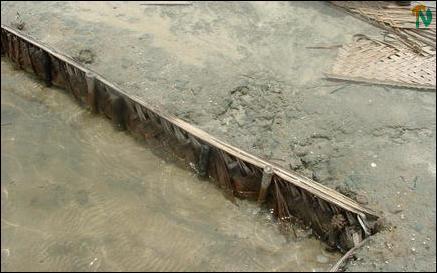 Wooden planks that normally line the edges of the pans are replaced with cadjan (coconut leaves)
Wooden planks that normally line the edges of the pans are replaced with cadjan (coconut leaves)The Paranthan Chemical factory, which was totally destroyed during the war used roughly 100 tons/month of salt and produced export quality sodium chloride in the 90s. Large amount of salt is also used by the dried fish and leather tanning industries.
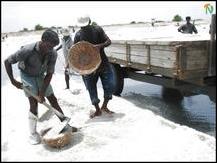 |
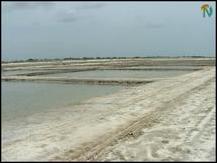 |
| Tractors carrying salt from buffer tanks for cleaning (Click for a larger picture) |
Array of rectangular salt pans (tanks) in Elephant Pass (Click for a larger picture) |
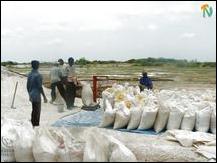 |
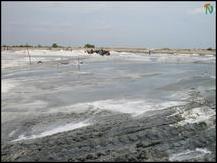 |
| Un-iodized salt being packed in larger containers (Click for a larger picture) |
Salt being harvested from buffer tanks (Click for a larger picture) |
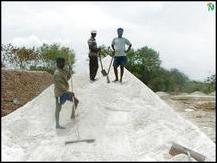 |
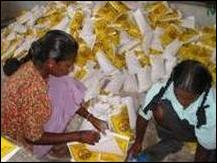 |
| Harvested salt being stock piled to wash impurities off (Click for a larger picture) |
Women workers manually packing iodized salt (Click for a larger picture) |
"We are eager to repeat our performance of a memorable day in 1990, when we loaded 13,000 metric tons of salt into a container ship anchored in Kurikattuvan harbor bound for Singapore," said a salt worker rehired to work at Elephant Pass.
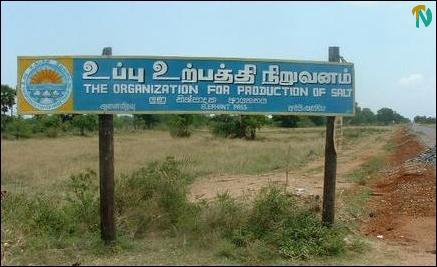 Salt Facts:
Salt Facts:
Sea water contains about 3.5% (by weight) dissolved minerals. Sodium chloride is 77% of that amount, or about 2.7% of seawater. The other 0.8% consists chiefly of calcium, magnesium and sulfate ions. As seawater evaporates, its volume decreases and the concentration of
sodium chloride in the resulting brine increases.
Salt crystals begin to form when the brine concentration reaches 25.8 % sodium chloride (NaCl). As evaporation proceeds, a layer of salt builds up on the earthen
crystallizer floors to a thickness of 10 to 25 cm (4-10 in). Sometimes, a layer of salt remains in the crystallizers as "salt floors" to provide support for "harvesting" equipment and to lessen the chance of clay or soil contamination of the salt.
Related Articles:30.04.03
Sustaining strategic parity and beyond 23.04.03
EPS fall: reassessing LTTE's manoeuvre warfare prowess 22.04.00
Elephant Pass overrun - LTTE 16.12.99
Tiger manoeuvres trouble gateway garrison

















